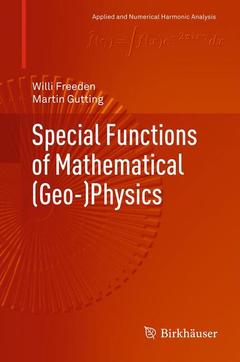Description
Special Functions of Mathematical (Geo-)Physics, 2013
Applied and Numerical Harmonic Analysis Series
Authors: Freeden Willi, Gutting Martin
Language: English
Subject for Special Functions of Mathematical (Geo-)Physics:
Publication date: 02-2015
501 p. · 15.5x23.5 cm · Paperback
Publication date: 02-2013
501 p. · 15.5x23.5 cm · Hardback
Description
/li>Contents
/li>Biography
/li>Comment
/li>
Willi Freeden: Studies in mathematics, geography, and philosophy at the RWTH Aachen, 1971 Diplom in mathematics, 1972 Staatsexamen in mathematics and geography, 1975 PhD in mathematics, 1979 Habilitation in mathematics, 1981/1982 visiting research professor at The Ohio State University, Columbus (Department of Geodetic Science and Surveying), 1984 professor of mathematics at the RWTH Aachen (Institute of Pure and Applied Mathematics), 1989 professor of technomathematics (industrial mathematics), 1994 head of the Geomathematics Group, 2002–2006 vice-president for Research and Technology at the University of Kaiserslautern, 2009 editor in chief of the International Journal on Geomathematics (GEM), 2010 editor of the Handbook of Geomathematics, member of the editorial board of seven international journals.
Martin Gutting: Studies in mathematics at the University of Kaiserslautern, 2003 Diplom in mathematics, focus on geomathematics , 2007 PhD in mathematics, postdoc researcherat the University of Kaiserslautern, lecturer in the course of geomathematics (in particular for constructive approximation, special functions, and inverse problems), 2011 lecturer for engineering mathematics at the University of Kaiserslautern and DHBW Mannheim.

